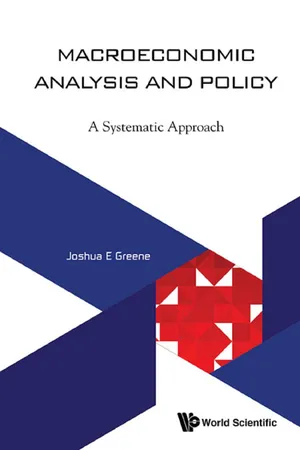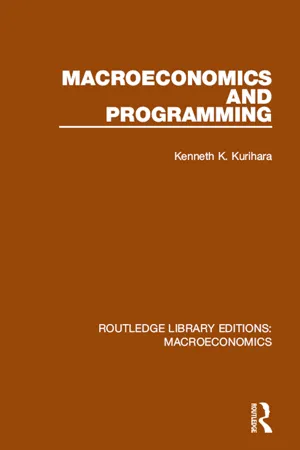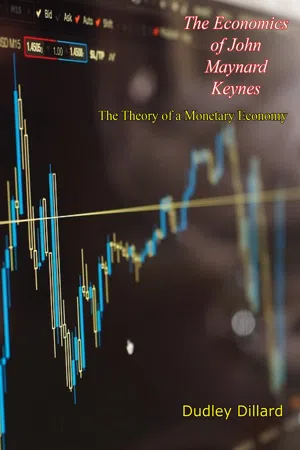Economics
Tax Multiplier
The tax multiplier measures the impact of changes in taxes on overall economic activity. It represents the change in aggregate demand resulting from a change in taxes. A higher tax multiplier indicates that changes in taxes have a larger impact on the economy, while a lower tax multiplier suggests a smaller impact.
Written by Perlego with AI-assistance
Related key terms
Related key terms
1 of 4
Related key terms
1 of 3
7 Key excerpts on "Tax Multiplier"
- eBook - ePub
- Alfred Schipke, Aliona Cebotari, and Nita Thacker(Authors)
- 2013(Publication Date)
- INTERNATIONAL MONETARY FUND(Publisher)
Tax and public expenditure multipliers provide a quantitative measure of the change in output resulting from an increase in taxes or government spending, and are key parameters for evaluating the effectiveness of fiscal policies in managing output fluctuations. A public spending multiplier greater than 1 indicates that public expenditure is able to stimulate economic activity and produce a final increase in output larger than the initial increase in public spending. A multiplier less than 1 means that the initial increase in aggregate demand is eroded by effects that counteract the initial unitary increase in public spending. These counteracting effects are often due to the crowding out of productive private sector activities and because part of the intended fiscal impulse translates into higher imports that do not increase output. Taxes are expected to have a negative effect on GDP, so a multiplier of less than –1 would imply that collecting one unit of taxes causes a decrease in economic activity larger than one unit. This outcome could be due to the accompanying distortions created by an increase in taxes or to disincentives for productive private sector activities. A Tax Multiplier less than zero but more than –1 indicates that economic activity is able to at least partially recover from the initial effect of the extraction of one unit of output in the form of taxes.An estimate of the size of fiscal multipliers is essential to the design and implementation of fiscal policies. If public spending multipliers are smaller than expected, a country’s economy may end up in a trajectory that compromises the sustainability of public finance because expansionary fiscal policies will fail to boost economic activity sufficiently, and public indebtedness (together with the associated debt service) will increase as a percentage of GDP. Also, a Tax Multiplier that is larger than expected may end up depressing economic activity more than anticipated, ultimately eroding the tributary base from which all taxes are collected.The magnitude of fiscal multipliers has been under close scrutiny since the 2008–09 global financial and economic crisis. The crisis prompted large government intervention through tax reductions and expenditure programs across the world aimed at preventing a global deflationary scenario (see, for instance, Spilimbergo and others, 2008 ; Freedman and others, 2009 ; Hall, 2009 ; and Spilimbergo, Symansky, and Schindler, 2009 - Charles Amo Yartey, and Therese Turner-Jones(Authors)
- 2014(Publication Date)
- INTERNATIONAL MONETARY FUND(Publisher)
Interpreting fiscal multipliers requires caution, because they are not deep structural parameters. Instead, they consist of policy reactions and structural parameters. That is, fiscal multipliers depend on various factors that can differ from case to case, such as the fiscal policy instrument, its duration, its associated fiscal adjustments, the stance of monetary policy, and country-specific circumstances. Multipliers are therefore best interpreted as empirical summaries of average output reactions following exogenous changes in government spending or tax revenue.Theories of Fiscal Multipliers
Different theories provide different mechanisms for fiscal multipliers, but they all highlight the importance of hours worked in explaining the short-run multipliers.2 Since the capital stock cannot be adjusted instantaneously, only hours worked can increase total output in the short term. Therefore, the short-run multipliers are essentially accounted for by the response of equilibrium hours worked to a fiscal policy and the extent to which those hours translate to output.The Keynesian tradition explains fiscal multipliers through demand-side effects. Assuming that an economy is constrained by demand, not by supply, Keynesian theory says that government spending increases demand, which raises incomes, which in turn leads to private sector spending. In the extreme case where wages and prices do not respond, the multiplier is given by 1/(1 − mpc ) for spending and —mpc /(1 − mpc ) for taxes, where mpc is the marginal propensity to consume. The multipliers become smaller according to the extent of price adjustment, and zero in another extreme case where wages and prices are infinitely responsive. The multipliers also depend on the monetary policy; they become larger when the central bank keeps the nominal interest rate constant. In a new Keynesian model calibrated to the U.S. economy, Christiano, Eichenbaum, and Rebelo (2011)- eBook - ePub
Macroeconomic Analysis and Policy
A Systematic Approach
- Joshua E Greene(Author)
- 2017(Publication Date)
- WSPC(Publisher)
fiscal multiplier. The fiscal multiplier is the ratio of the change in nominal GDP to a change in revenues or expenditures that causes it. Fiscal multipliers arise because changes in revenues and expenditures affect aggregate demand. Tax cuts leave more after tax income available for consumption or investment, while higher expenditures raise spending directly (if government increases its purchases) or indirectly (if higher government benefit payments raise consumption). Fiscal multipliers typically increase over time, as the spending of one person or firm becomes the income of other firms or persons who, in turn, use that for further spending. Eventually, the size of the multiplier reaches a practical limit, as taxes and other withdrawals (e.g., spending for imports) gradually reduce the increment to spending from each additional receipt of income.The size of the fiscal multiplier depends on a variety of factors. These include:•The type of fiscal measure: multipliers for tax cuts and spending increases aimed at those more likely to spend the additional income are typically higher than for measures aimed at those who may save a notable part of additional income. Thus, raising unemployment benefits, creating temporary employment programs for the unemployed, and increasing transfers to the poor will likely have higher multipliers than tax cuts for the rich. In addition, spending increases often have higher multipliers than tax cuts, because the spending adds directly to aggregate demand, while only the part of a tax cut that is spent does so.•The nature of the economy (open or closed): in open economies, with a higher ratio of total trade to GDP, a higher share of any new spending is likely to go for imports (and thus not raise GDP directly) than is true in a more closed economy, with a lower ratio of trade to GDP.•The state of economic development: fiscal multipliers are thought to be higher in more advanced economies, perhaps because in less advanced economies the formal sector is smaller.•The type of exchange regime - No longer available |Learn more
Contemporary Economics
An Applications Approach
- Robert Carbaugh(Author)
- 2016(Publication Date)
- Routledge(Publisher)
1 . This fourfold increase in aggregate demand is attributable to the multiplier effect.Figure 13.4 Fiscal Policy and the Multiplier EffectNotice that this particular increase in aggregate demand takes place within the horizontal region of the aggregate supply curve, where the economy’s price level is constant. Thus, real output will increase by the full amount of the multiplier. Moreover, unemployment will decline as firms employ workers who were laid off during the recession.In estimating the effects of fiscal policy, the multiplier is of crucial importance. Economists have debated the size of the multiplier for years. When J. M. Keynes and his colleagues first developed the concept of the multiplier in the 1930s, they estimated that the size of the government spending multiplier was as large as 10. This means that for every $100 increase in government spending, real GDP would increase by $1,000. More recent research indicates that the spending multiplier is much smaller than earlier analyses had assumed, reduced by the effect of a larger national debt on long-term interest rates, a crowding out of interest-sensitive spending caused by higher interest rates, and so on. Most researchers currently estimate the value of the government spending multiplier to be less than 2. - eBook - ePub
- Kenneth K. Kurihara(Author)
- 2015(Publication Date)
- Routledge(Publisher)
t. In that case the multiplier formula becomeswhere is the constant private marginal propensity to save and t the variable public marginal propensity to tax in general, while ΔG is the government-expenditure multiplicand and ΔI the private-investment multiplicand.Three important reservations must be borne in mind here, however. First, unlike government expenditure, tax cuts (including Δτ < 0 and Δt < 0) are not subject to direct public control with respect to their actual spending in the right amount, at the right time, or on the right goods and services. Those who prefer tax cuts to government expenditure as a countercyclical (esp. anti-recession) measure often fail to realize this difficulty inherent in a mixed economy which leaves tax-payers free to dispose of tax-released purchasing power irrespective of repercussions on the whole economy. Second, if a tax cut is such as to stimulate private investment in fixed capital, instead of working capital, the result may prove disappointing. For tax-stimulated investment of the capacity-creating variety, while offsetting savings to generate demand, nevertheless adds fuel to the fire at a time when the presence of idle plant and equipment may already be narrowing the scope for profitable investment opportunities. Lastly, one-sided revenue considerations, if not vested interests, may frustrate attempts to remove or reduce regressive sales or excise taxes bearing more heavily on the poor than on the rich, even when such attempts could otherwise promote both stability and welfare.THE MULTIPLIER EFFECT OF A BALANCED BUDGETThe question has been asked as to what effect a balanced national budget would have on total income and employment. The so-called ‘balanced-budget theorem’ has it that the multiplier effect of a balanced budget is exactly unity (ΔY/ΔG = 1; ΔG = ΔT).13 - eBook - ePub
- Arleen J Hoag, John H Hoag(Authors)
- 2006(Publication Date)
- WSPC(Publisher)
Government, consumer, and business spending determine the equilibrium level of income. We have examined two impacts of government — taxation and expenditure. To finance expenditure, the government collects taxes. Taxes affect consumption as well as investment. Because the consumer must pay taxes, the consumer has less income to spend on consumption, so consumption falls. A major impact of taxes is to reduce consumption and thus reduce total spending. Government takes the taxes collected and contributes to total spending. Taxes influence the spending of business and consumers and reduce aggregate demand, while government spending increases aggregate demand. These are two significant influences of government. The equilibrium level of income was again established in this model, which now includes the government. The aggregate demand of the three sectors, C + I + G at each price level, determines equilibrium.The income multiplier tells us that if there is an increase in spending, the equilibrium level of income will rise by a multiple of the increase in spending. If there is a decrease in spending, the equilibrium level of income will fall by a multiple of the decrease in spending. The size of the income multiplier depends on the marginal propensity to save. The smaller the MPS, the larger the income multiplier. The multiplier is an important concept that will be used in the following chapters. The next chapter develops the Keynesian Cross, a graph, to illustrate the equilibrium level of income.Key Conceptsdisposable income taxes government spending equilibrium income multiplier automatic stabilizersDiscussion Questions1. The Full Employment Act of 1946 made the federal government responsible for maintaining full employment. We were concerned with sliding back into another depression. How did this contrast with the attitude toward government involvement in the macro economy prior to the Great Depression?2. What is the effect of an increase in taxes on aggregate demand? A decrease in taxes? An increase in government spending? A decrease?3. Suppose that government spending goes up in the bathtub model so that I + G is greater than S + T. The level of income will rise. Why will the level of income stop rising and achieve a higher equilibrium?4. Suppose that all consumers try to save more. What will happen to the level of income and saving?5. Consumption, C, is determined by consumers following their best interest. Investment, I, is determined by businesses following their best interest. Yet C +1 could leave us at less than full employment. Apply the fallacy of composition. What can the government do to look after the best interest of society? - eBook - ePub
The Economics of John Maynard Keynes
The Theory of a Monetary Economy
- Dudley Dillard(Author)
- 2018(Publication Date)
- Papamoa Press(Publisher)
THE ULTIMATE purpose of Keynes’ theory is to explain what determines the volume of employment. The starting point is the principle of effective demand, which states that employment depends on the sum of consumption expenditures and investment expenditures. Consumption depends on the size of consumers’ net income and the propensity to consume, and investment depends on the marginal efficiency of capital taken in conjunction with the rate of interest. A high propensity to consume is favorable to employment, and one of the remedies for unemployment is to be found in measures designed to increase the propensity to consume. When investment increases and causes income to rise, the resulting additions to income are expended largely for consumption. The relationship between increases in investment and increases in consumption, which was discussed in a preliminary fashion in Chapter 3, is explored more fully in the present chapter in terms of the investment multiplier, which is the ratio of an increase of income to a given increase in new investment. In common-sense terms, the investment multiplier means that when investment increases, national income will increase not only by the amount of investment but by some multiple of it. The great practical significance of the multiplier arises in relation to Keynes’ advocacy of public investment and other forms of governmental expenditure as a source of effective demand in periods in which private enterprise does not furnish adequate investment to provide full employment of labor and other resources.The Concept of the Propensity to Consume
The propensity to consume, which is simply the relationship between income and consumption, may be represented by means of a diagram. If values for income (Y) are plotted along the horizontal axis and consumption (C) along the vertical axis, the line which relates these two variables represents the schedule of the propensity to consume, or what is called for the sake of brevity, the propensity to consume. This schedule of the propensity to consume may also be referred to as the “consumption function” because it shows the functional relationship between the two variables, income and consumption. “Propensity to consume” does not mean a mere desire to consume, but the actual consumption that takes place, or is expected to take place, out of varying amounts of income. In this respect it is similar to a demand schedule, which refers not to mere desire to buy but to willingness plus ability to buy. The data on income and consumption in a schedule of the propensity to consume may he either for the community as a whole or for an individual consuming unit. In Keynes’ analysis of aggregates, as previously indicated, it is the national income and national consumption that are significant. When used without qualification, “propensity to consume” or “consumption function” will mean the community or aggregate concept, and in other cases the adjective “family” or “individual” will be used.
Index pages curate the most relevant extracts from our library of academic textbooks. They’ve been created using an in-house natural language model (NLM), each adding context and meaning to key research topics.
Explore more topic indexes
Explore more topic indexes
1 of 6
Explore more topic indexes
1 of 4






